NOTE – Sorry for the lengthy post on such a simple filter change and transmission flush, but as I got into this project, I discovered other issues that needed attention.
When we bought our Southwind a couple years ago, I noted our transmission (4R100) had an aftermarket in-line filter installed in the cooling line. This was part of a Ford TSB for early model 1999 and 2000 F53. I also noted the inline filter had a small leak out the end. I read about this problem somewhere so planned on replacing the in-line with a spin-on filter.
Our 19 year old Southwind (F53 chassis) has 65k miles on it. I suspect the transmission fluid / filters have never been changed. On our 7500 mile trip last winter (2017/2018), I never experienced any transmission issues. To make sure the preventative maintenance was up to date, I decided to flush the transmission and replace the filters. When I drained the fluid, the color was a little brownish and there wasn’t any burn smell. The magnet had some fuzz on it, Everything looked normal.
The owners manual calls for MERCON ATF fluid, I used Valvoline ATF Full Synthetic which is compatible with MERCON ATF. The flush process took 5 gallons of Valvoline ATF Full Synthetic (Walmart $18 a gallon) and a Fram FT1131A internal filter.
IMPORTANT – The FT1131A is for a shallow pan, we have the deep pan. The short pan filter will work, but won’t be able to take advantage of the additional fluid depth in the deep pan. i.e. the pickup tube doesn’t go all the way to the bottom of the deep pan. When you buy your filter, make sure to get the one for the deep pan.
I replaced the external in-line filter with a WIX 51622 spin on filter. I also replaced the transmissions vent hose that was plugged. AND, I discovered a couple things about my transmission cooling system that I’ll deal with next spring.
WHAT I LEARNED ABOUT THE F53 TRANSMISSION COOLING SYSTEM
Most cars and later model F53s have a transmission cooler that’s an integral part of the vehicles cooling system radiator, a tube that passes through the lower tank portion of the vehicles radiator. Transmission fluid passes through this tube, hot transmission fluid is cooled when the heat gets transferred into the vehicles normal antifreeze coolant. In addition to the vehicles radiator, chassis builders also add an external radiator type cooler to supplement cooling.
The first couple years of the V10 / 4R100 powered F53 didn’t have a cooler in the cooling system radiator, only an external transmission radiator. The radiator does a good job when the vehicle is moving down the road and air is flowing through the radiator, but when doing stop and go or traveling at low speed, there is little air flow through the radiator.. This is probably why there were a lot of reports of transmission over-temp and limp mode events in these early F53’s. Ford issued a TSB on these early F53s to install an in-line filter whenever they were servicing a F53. Also – If they replaced a transmission, they’d also install an in-line filter with the new transmission. These filters helped remove any small debris in the fluid, but didn’t do anything to address the cause, the cooling system.
Another issue that effects all 4R100’s regardless of year is the pressure relief bypass tube. There is a misunderstanding in the community that this is a temperature bypass, i.e. it senses fluid temperature and bypasses the cooling system when the temperature is cold. WRONG.. This is a pressure bypass. If the cooling loop gets plugged, this tube will bypass the cooling system and continue sending fluid to the back of the transmission.
There’s an issue with the tubes internal pressure relief valve that it can get weak and bypass all the time. When this happens hot fluid doesn’t get routed through the cooling system. This contributes to a transmission overheat / limp mode event.
THREE RESOLUTIONS TO CONSIDER FOR THE F53 COOLING SYSTEM
1) Install updated radiator with integral transmission cooler.
Replace original F53 engine cooling system radiator with one that has the transmission cooler in it. This would only impact the early model F53 (1999 – 2000). I priced radiators on Rock Auto. They had a Spectra Premium, 2 row, with the transmission cooler heat ex-changer for $130 (model CU2171). I wish I had replaced the radiator when I had it out while doing my broken exhaust studs. I’ll probably do this next spring or summer
2) Add / replace in line filter.
There’s a lot of discussion in different forums regarding filters. My thoughts are if the filter can trap some of the real small stuff, this should contribute to the longevity of the transmission. If the filter is catching big stuff, the transmission is probably failing in a catastrophic manner. Also consider, if the filter gets plugged, does it have an internal bypass. Yes, the filter I’m using will bypass.
The Ford TSB uses an inline filter that has an internal bypass. The only issue I have with these filters is reports of leaks on the end of the filter. Mine is leaking.
There are numerous aftermarket schemes for filters that the Ford diesel people are using in their 4R100 transmissions. I’ve chosen to replace my current leaking in-line with one of these systems. It looks like a regular oil filter, I bought a remote filter adapter (Derale 15708) and plumbed it into the cooling line. IMPORTANT – This adapter has a 3/4-16 filler thread If you decide to use the Luber Finer LFP5570 filter. it has a 1 1/8-16 thread. I screwed up, so rather than replace the adapter, I searched the WIX site and found a filter that they use on Allison transmissions that had the 3/4-16 thread, WIX 51622.
3) Pressure bypass relief tube.
The bypass valve is there in case the cooling system becomes plugged, The bypass will open and continue flow of fluid to the back of the transmission.
If the bypass valve or becomes weak, it bypasses all the time, thus reducing flow to the cooling system. This will result in an overtemp / limp mode event.
The argument is, what could cause the cooling system to become plugged.. There doesn’t seem to be an answer to this that doesn’t include a transmission that has already imploded.
There are three thoughts on the pressure relief bypass tube:
a) When servicing the transmission, rebuild the bypass tube. There is a kit for this, Sonnax 36605-02K. It has the o-rings, ball, spring, valve seat, etc to repair the bypass valve tube. This kit runs between $20 – $30 depending where you get it. (This is the option I decided to take)
b) Delete the bypass tube. There are a couple methods of doing this, The easiest way is to replace the bypass tube with large spacers on the bongo fittings. Deleting the bypass forces all fluid through the cooling system. If you do this, consider a filter that has a bypass built in to it.
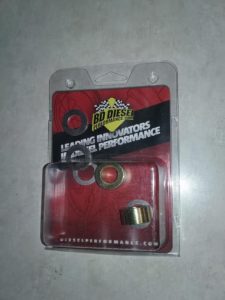 c) When selecting an in-line filter, select one that has a pressure relief valve. In the unlikely event the filter becomes plugged, the valve opens and allows unfiltered fluid to continue to circulate through the transmission cooling system. The Wix 51622 is used in Allison transmissions. It will bypass at 7-9 psi.. I’m doing this also.
c) When selecting an in-line filter, select one that has a pressure relief valve. In the unlikely event the filter becomes plugged, the valve opens and allows unfiltered fluid to continue to circulate through the transmission cooling system. The Wix 51622 is used in Allison transmissions. It will bypass at 7-9 psi.. I’m doing this also.
I’ve decided to install the Wix filter (with internal bypass) and rebuild the bypass valve. Next spring I’ll replace the OEM radiator with the newer model that has an integral transmission cooler.
FLUSHING THE TRANSMISSION
Doing a complete transmission flush is fairly easy. I use the method that Mark Kovalsky suggests, with a slight variation.
I drained the pan and replaced the internal filter. A note of caution when removing the old filter, make sure the old o-ring is accounted for. Mine was stuck up inside the transmission and didn’t come out with the old filter. Make sure to remove the old o-ring. (NOTE – If you forget to do this, there is enough room that the new o-ring will push the old o-ring up into the pickup port. I wouldn’t worry about it or tear everything back apart. )
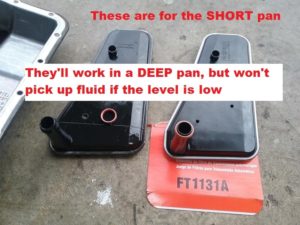 IMPORTANT UPDATE – The filters shown in the above photo are the wrong filters for my F53 motorhome 4R100. I installed the FRAM FT1131A because it was identical to the one that I removed (also the wrong one). These filters are meant for a “shallow” pan. My transmission has a “deep” pan. The difference between the “deep” and the “shallow” is the length of the pickup on the filter. The “deep” filter, the pickup is about 2 inches long. The “shallow” filter will work in a “deep” pan, but if the transmission fluid level is significantly low, the shallow filter will not be able to pick up fluid from the low level in the pan.
IMPORTANT UPDATE – The filters shown in the above photo are the wrong filters for my F53 motorhome 4R100. I installed the FRAM FT1131A because it was identical to the one that I removed (also the wrong one). These filters are meant for a “shallow” pan. My transmission has a “deep” pan. The difference between the “deep” and the “shallow” is the length of the pickup on the filter. The “deep” filter, the pickup is about 2 inches long. The “shallow” filter will work in a “deep” pan, but if the transmission fluid level is significantly low, the shallow filter will not be able to pick up fluid from the low level in the pan.
I cleaned the inside of the pan and carefully cleaned the fuzz off of the magnet. I re-installed the pan using the re-usable gasket.
Add 2 gallons of fluid to the pan.
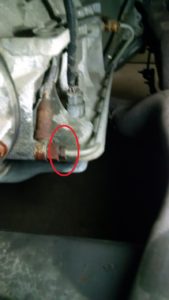 Remove the cooling line return (the fitting on the back of the transmission, not the bypass tube.). I used a short section of hose over this tube, put the other end of the hose in a 5 gallon bucket.
Remove the cooling line return (the fitting on the back of the transmission, not the bypass tube.). I used a short section of hose over this tube, put the other end of the hose in a 5 gallon bucket.
Start the engine and run it until the flow stops or you have 2 gallons in the bucket. Stop the engine. (The flow will stop when the pan is empty. DO NOT continue to run the engine once the flow stops)
Add 1 1/2 gallons of fluid back into the transmission (this makes 3 1/2 gallons used so far)
Start the engine, with the engine is running, shift it into D, N, and R for about 5 seconds each. Run it until the flow stops or you have 2 gallons in the bucket, stop the engine. At this point, you may see the color start to change if your fluid was dirty.
Reconnect the cooler line to the transmission. Add 1 1/2 gallon of fluid back into the transmission. Run the engine, shift into D, N, and R for a few seconds. With the engine idling and in PARK, check the level on the dip stick.
ADDING FLUID TO THE TRANSMISSION
The only way to get fluid into the transmission is filling at the dipstick tube. I’ve done this before on my 2001 F53 (Mirada) but was having a very difficult time getting fluid to flow into the transmission in my 1999 Southwind (F53). The flow was very slow, and the fluid would bubble back out the dipstick tube.
a) There’s a long rubber hose inside the dip stick tube. I noticed this when I had the engine torn apart for replacing broken studs. I removed this hose, but this didn’t seem to help a lot.. (NOTE – I suspect the hose is in there to protect the tube and the dip stick from rubbing together, maybe??)
b) Fluid shouldn’t be bubbling back out the dip stick tube. There’s a vent on top of the transmission, this should allow the transmission to breath. IT WAS PLUGGED. The rubber hose that was attached to the top vent was plugged, I couldn’t blow through it. I replaced the rubber hose and after that I had no problems filling through the dip stick.
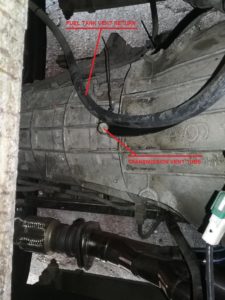
Once I replaced the plugged vent hose, I was able to fill the transmission normally. I may re-insert the rubber hose back inside the dip stick tube.
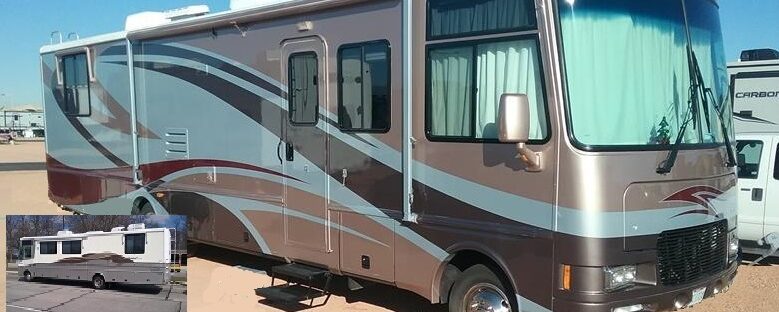
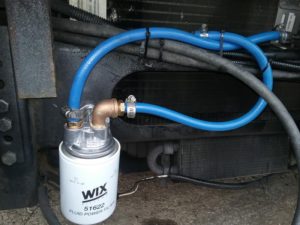
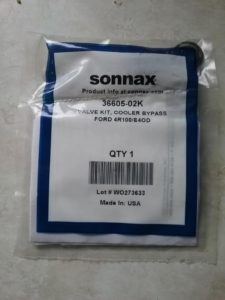
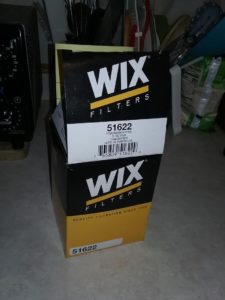
Pingback: Upgrade report – A little more power and better fuel economy – 1999 Southwind 35S
I have a 2000 Dutch Star with a 2000 Ford F53 chassis. I want to tow a light truck/car behind RV. Have you upgraded radiator? Seems like best choice for me. Any tips?
thanks for all your info!!!!!!
I tow a 3000 lb Saturn Vue with no problems. I’m still running the original radiator that doesn’t have a tranny cooler. If I remove it for any reason in the future, I’ll replace it with one that has a integral cooler.
In the meantime, I keep an eye on tranny temperature when operating at low speed, stop and go traffic, hot outside, Anytime I’m stopped I put it in “N” to eliminate torque converter slippage. If the speeds are low, say 10-15 mph, I’ll manually shift to 1st to prevent the trans from upshifting.
Isn’t there a drain plug on the torque converter?
Yes, I believe some of the early 4R100 torque converters had one. I didn’t use it when I flushed.
If you drain both the pan & torque converter, you can get about 15qts out. After pulling the torque converter drain cover, you have to turn the motor over until the drain plug lines up with the hole.
I recently started having issues with my transmission going into limp mode and engine running hot. I was towing a 14′ dual axle enclosed trailer with 2 50cc dirt bikes inside. I am going to swap out my radiator as i have started to notice sediment build up in the reservoir. I did flush it but it still is running hot. I also changed the thermostat to a 180. I’m hoping this change will Take care of both of my issues. Great write ups btw!
What year is you motorhome?
Thanks for all the great info. I’m going to take your advise and put an inline filter on the return line from the cooler on my 1999 Bounder. Will I need to flare and put proper connectors on the return line or did you just slide hose over and use hose clamps? Not sure what the line pressure is.
The filter housing had barbed fittings, so thats what I used.
I purchased the same set up as you, so was planning on using the barbed fittings on the housing, in and out, but I can’t quite see in your pic what you used to hook in the hose’s to steel line running from the cooler.
If I remember right, I used a tube cutter to cut the tube, then used a flare tube to put just a little lip on the ends of the tube before pushing the hoses on the tubes. The little lip kind of acts like a barb.
OK, thanks. That’s what I was thinking of doing. Thanks so much for sharing all your projects. It’s saved me hours of research with my 99 Bounder project. Cheers